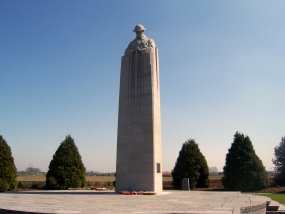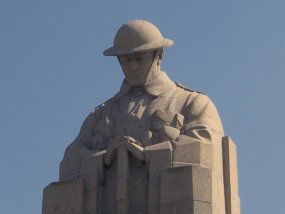
WWII: Maginot Line | Normandy | V-Weapon Sites | Arnhem
Further afield: Crete
| Home Tracing Military Ancestors Travel Advice CWGC Cemeteries Iron Harvest News Book Reviews Glossary Links Contact Me Ypres:
 
|
Core Location 6 – Vancouver Corner, St Juliaan
Directions – Leaving Langemarck German Cemetery, pass back through the village and carry on straight ahead when you reach the crossroads, following signs for Zonnebeke. Within 5 minutes, you’ll reach another crossroads. Again go straight across and park on the left next to the memorial of the Brooding Soldier. Practical Information – This site is a common stop-off for Canadian visitors and can get busy. Try to reach the spot mid-morning if possible to avoid the worst of the crowds. From the orientation platform at the base of the memorial, the visitor has an excellent view of the northeastern part of the Salient stretching up to Passendale village whose church can be glimpsed on the skyline. Historical Notes – The memorial of the Brooding Soldier is one of the iconic images of First World War remembrance. It was erected to commemorate the 18,000 Canadians who defended this part of the Salient during the gas attack of April 1915 – 2,000 of whom were killed. This area was defended by soldiers of the Canadian 2nd and 3rd Brigades throughout the 23rd and 24th April supported by a makeshift task force of British units known as “Geddes Detachment” after its commanding officer. With just wet cloths tied around their noses and mouths to protect them from the gas, they fought heroically to defend Ypres from four German divisions. The scale of their losses is testament to their bravery. Eyewitness Account – During Third Ypres, tanks were used here to support the attack on the German defences. H.R. Brewer recalls the scene: "The guns have to be got out of their pits through feet of thick mud. We happen to one of the unfortunate batteries to take one of the foremost positions and found ourselves beyond St Julien. The village of St Julien is so reduced by our guns that we walk over it and take our wagons over what used to be houses. Extract taken from Flanders Then & Now, The Ypres Salient and Passchendaele by John Giles, Battle of Britain Prints International Ltd 1995. |
|||||


